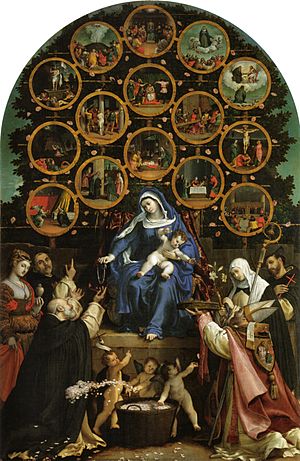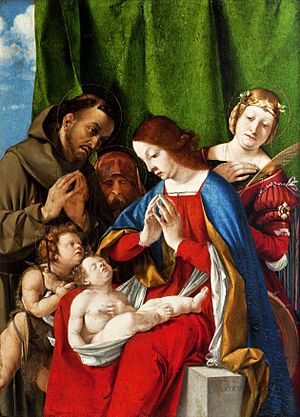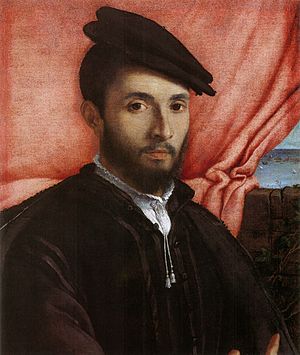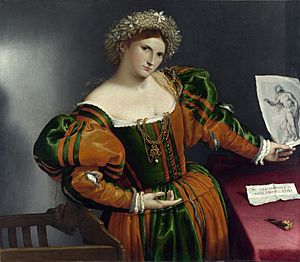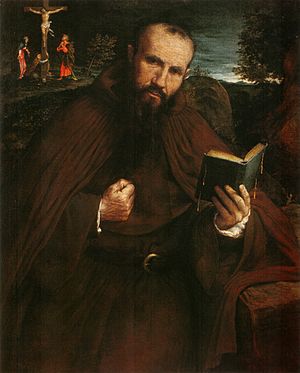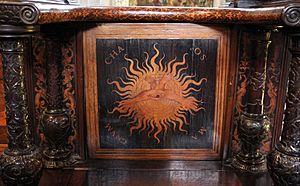Lorenzo Lotto facts for kids
Quick facts for kids
Lorenzo Lotto
|
|
|---|---|

Possible self-portrait by Lorenzo Lotto, 1540s, Thyssen-Bornemisza Museum
|
|
| Born |
Lorenzo Lotto
c. 1480 Venice, Italy
|
| Died | 1556/57 Loreto, Marche, Italy
|
| Nationality | Italian |
| Known for | Painting |
|
Notable work
|
Polyptych of Saint Domenico |
| Movement | High Renaissance |
| Signature | |
Lorenzo Lotto (born around 1480 – died 1556 or 1557) was an Italian painter. He was also a skilled draughtsman (someone who draws well) and illustrator. He is usually considered part of the Venetian art school. However, he spent much of his career in other cities in northern Italy.
Lotto mostly painted large artworks for churches, religious scenes, and portraits of people. He was active during the High Renaissance period and the first half of the Mannerist period. His art style stayed quite similar throughout his life. Yet, his unique way of showing people in unusual poses helped bridge the gap to the Mannerist style.
Contents
A Famous Italian Painter
During his life, Lorenzo Lotto was a well-known painter. He was especially popular in Northern Italy. Even though he's linked to the Venetian School, he mostly worked independently. He wasn't as famous in Venice as he was in other towns. This was because his style was very unique.
After he died, people slowly forgot about his work. One reason for this might be that many of his paintings are in smaller churches or local museums.
Lorenzo Lotto's Life Story
Lorenzo Lotto was born in Venice. He traveled and worked in many different Italian cities:
- Treviso (1503–1506)
- The Marche region (1506–1508)
- Rome (1508–1510)
- Bergamo (1513–1525)
- Venice (1525–1549)
- Ancona (1549)
- Finally, as a religious brother, in Loreto (1549–1556)
Learning to Paint
We don't know much about how Lotto learned to paint. Since he was from Venice, he was influenced by the famous painter Giovanni Bellini. Lotto knew a lot about Venetian painting of his time. Bellini probably wasn't his direct teacher, but his influence is clear in Lotto's early painting, Virgin and Child with St. Jerome (1506).
However, in his portraits and an early painting called Allegory of Virtue and Vice (1505), he also showed the influence of Giorgione. Giorgione was known for his "Naturalism," which meant painting things very realistically. As Lotto got older, his style changed. It became more dramatic, like the work of his friend Correggio from Parma.
Working in Treviso (1503–1506)
Lotto soon left Venice. There was too much competition for young painters there. Famous artists like Giorgione and Titian were already very popular. However, the writer Giorgio Vasari mentioned that Lotto was a friend of another painter, Palma the Elder.
In Treviso, a busy town near Venice, Lotto found a supporter in Bishop Bernardo de' Rossi. The painting Allegory of Virtue and Vice was made as a symbolic cover for the bishop's portrait (1505). It was painted after the bishop survived an attack.
Lotto's painting St. Jerome in the Desert (1500 or 1506) shows his early skills. The dramatic rocky background and the saint's red clothes stand out. He also showed his early talent for painting tiny, detailed scenes. He painted his first large church artworks for a church in San Cristina al Tiverone (1505) and a church in Asolo (1506). You can still see these paintings in those churches today.
Time in Recanati (1506–1508) and Rome (1508–1510)
In 1508, Lotto started a large altarpiece called the Recanati Polyptych. A polyptych is a painting made of several panels. This one had six panels and was for the church of San Domenico. His portraits from this time include Young Man against a White Curtain (around 1506) and Adoration of the Child (around 1508). The second painting shows Catherine Cornaro, Queen of Cyprus, as Saint Catherine.
As Lotto became more respected, he caught the eye of Bramante, a famous architect. Bramante invited Lotto to Rome to decorate the Pope's apartments. Sadly, none of this work survived. It was destroyed a few years later. This was probably because Lotto had copied the style of Raphael, who was a rising star at the Pope's court. Lotto had done this before in the Transfiguration part of the Recanati polyptych.
The Marche (1511–1513) and Bergamo (1513–1525)
In 1511, Lotto worked for a religious group in Jesi, painting an Entombment. Soon after, he painted altarpieces in Recanati. These included a Transfiguration (around 1512) and a fresco (wall painting) of St Vincent Ferrer.
His time in Bergamo was his most successful and productive period. Bergamo was the westernmost town in the Venetian republic. There, he received many orders from rich merchants, educated professionals, and local nobles. Lotto became very good at using rich colors and was an experienced draughtsman. He also developed a new way of painting portraits. He tried to show the inner thoughts and feelings of the people he painted. This continued a tradition started by Antonello da Messina. A good example is his Portrait of a Young Man with a Book.
In 1513, he started a huge altarpiece called the "Martinengo Altarpiece" for a church in Bergamo. This artwork was ordered by Count Alessandro Martinengo-Colleoni. It was finished in 1516 and shows the influence of Bramante and Giorgione. His next jobs were decorating the churches of S Bernardino and Sant'Alessandro in Colonna with frescoes and other paintings. He finished five more altarpieces between 1521 and 1523. In 1523, he briefly visited the Marche region. There, he got more orders for altarpieces, which he would paint later in Venice.
Most of his next works were wall paintings. In 1524, he painted a series of frescoes showing the lives of saints in the Suardi Chapel near Bergamo. In these detailed paintings, he showed scenes from each saint's life. For example, in the fresco Martyrdom of St. Claire, he painted Christ with vines growing from his hands. This illustrates a Bible verse: "I am the vine, you are the branches." In 1524, he also drew large pictures (called cartoons). These were models for the intarsia panels (wood inlay designs) for the choir stalls of Santa Maria Maggiore in Bergamo.
More than 20 private paintings date from this time. Most of them were religious, like paintings of the Madonna or a Deposition. These were used for worship at home. Lotto painted in the traditional style, but he added his own personal touch. He used contrasting poses and movements to make his paintings more emotional. He often broke the usual balanced look of the Virgin Mary surrounded by angels and saints.
Life in Venice (1525–1532)
When Lotto first moved to Venice, he lived in a monastery. But he had to leave after a few months because of a disagreement with an artist named Fra Damiano da Bergamo. To handle all the painting orders he was getting, he started his own workshop. He sent five altarpieces to churches in the Marche region. He also sent one to a church in Celano and another to the Venetian church of Santa Maria dei Carmini. This last one showed St. Nicholas of Bari in Glory.
Venice was a very rich city, and Lotto became more popular. He received many orders for private paintings, including ten portraits. One famous one is Portrait of a Young Man. His portrait of Andrea Odoni (1527) later influenced a portrait by Titian (1568). But in Venice, Lotto was often overshadowed by Titian, who was the most famous artist there.
Later Years (1532–1556)
In the last part of his life, Lorenzo Lotto moved often. He was always looking for people to support him and give him painting jobs. In 1532, he went to Treviso. Then he spent about seven years in the Marche region before returning to Venice in 1540. He moved again to Treviso in 1542 and back to Venice in 1545. Finally, he went back to Ancona in 1549.
This was a very productive time for him. He painted several altarpieces and portraits.
Towards the end of his life, Lotto found it hard to make enough money. Also, in 1550, when he was around 70, one of his artworks didn't sell well at an auction in Ancona. This made him very sad, as he wrote in his personal notebook. Since he was a very religious man, in 1552 he joined the Holy Sanctuary at Loreto. He became a lay brother, which is a religious person who is not a priest. During this time, he decorated the basilica of Santa Maria. He also painted a Presentation in the Temple for the Palazzo Apostolico in Loreto. He died in 1556 and was buried, as he wished, in a religious habit.
Giorgio Vasari included Lotto's life story in his book Vite. Lorenzo Lotto himself left many letters and a detailed notebook (Libro di spese diverse, 1538–1556). These writings give us a lot of information about his life and work. Many painters were influenced by him, including Giovanni Busi and Ercole Ramazzani. Another student of his was Durante Nobili.
Thanks to the art historian Bernard Berenson, Lotto's work was rediscovered in the late 1800s. Since then, many books and art shows have been dedicated to Lorenzo Lotto. These include exhibitions in Venice in 1953 and at the National Gallery of Art in Washington, USA, in 1998.
Selected Works
- Madonna with Child, St. Peter of Verona and Donor (1503). National Museum of Capodimonte, Naples
- Santa Cristina al Tiverone Altarpiece (c. 1504–1506). Church of Santa Cristina al Tiverone, Quinto di Treviso, Veneto
- Allegory of Virtue and Vice (1505). National Gallery of Art, Washington, USA
- Allegory of Chastity (c. 1505). National Gallery of Art, Washington
- Madonna with Child and Saints (c. 1505). Scottish National Gallery, Edinburgh, United Kingdom
- Asolo Altarpiece (1506). Cathedral of Asolo, Veneto
- Recanati Polyptych (1506–1508). Civic Museum Villa Colloredo Mels, Recanati
- Portrait of a Young Man with a Lamp (c. 1506). Kunsthistorisches Museum, Vienna
- Saint Jerome in Penitence (c. 1506). Louvre, Paris
- Saint Joseph and the Virgin Suitors (c. 1508). Thyssen-Bornemisza Museum, Madrid
- Mystic Marriage of Saint Catherine (1506–1508), Alte Pinakothek, Munich
- Madonna with Child between Sts. Flavian and Onuphrius (1508). Borghese Gallery, Rome
- Saint Jerome in Penitence (c. 1509). Museo nazionale di Castel Sant'Angelo
- Transfiguration (1510–1512). Civic Museum Villa Colloredo Mels, Recanati
- Martinengo Altarpiece (1513–1516), Santi Bartolomeo e Stefano, Bergamo
- Saint Jerome in Penitence, (1515). Allentown Art Museum, Pennsylvania
- Susanna and the Elders (1517), Uffizi Gallery, Florence
- Portrait of Lucina Brembati (c. 1518). Accademia Carrara, Bergamo
- Madonna and Child with Saint Roch and Saint Sebastian (c. 1518). National Gallery of Canada, Ottawa
- Holy Trinity (c. 1519–20). Museo Adriano Bernareggi in Bergamo.
- Christ Taking Leave of his Mother (Lotto), Gemäldegalerie, Berlin
- Santo Spirito Altarpiece (1521). Church of Santo Spirito, Bergamo
- Adoration of the Child (1523). National Gallery of Art, Washington, USA
- Marsilio Cassotti and His Bride Faustina (1523). Prado Museum, Madrid
- Mystical Marriage of St Catherine of Alexandria (1523). Accademia Carrara, Bergamo
- Ritratto di coniugi (1524). Hermitage Museum, Saint Petersburg, Russia
- Christ Carrying the Cross (1526). Louvre, Paris
- Portrait of a Young Man with a Book (c. 1526) Pinacoteca del Castello Sforzesco, Milan
- Portrait of Andrea Odoni (1527). Royal Collection, London
- Madonna and Child with Saint Catherine and Saint James, (c. 1527). Kunsthistorisches Museum, Vienna
- Portrait of a Gentleman with a Lion Paw (c. 1527). Kunsthistorisches Museum, Vienna
- Saint Nicholas in Glory (1527–1529). Santa Maria dei Carmini, Venice
- Triumph of Chastity (c. 1530). Palazzo Pallavicini Rospigliosi, Rome
- Venus and Cupid (c. 1530). Metropolitan Museum of Art, New York
- Saint Lucy Before the Judge (1532). Pinacoteca comunale, Jesi
- The Sleeping Child Jesus with the Madonna, St. Joseph and St. Catherine of Alexandria (1533). Accademia Carrara, Bergamo
- Portrait of a Lady as Lucretia (1533). National Gallery, London.
- Madonna with Child and Two Donors (c. 1533–1535). Getty Center, Los Angeles, US
- Recanati Annunciation (c. 1534). Civic Museum Villa Colloredo Mels, Recanati
- Holy Family with SS Jerome, Anna and Joachim (1534). Uffizi, Florence
- Holy Family with St. John the Baptist (c. 1536). Louvre, Paris
- Pietà (1538–1545). Pinacoteca di Brera, Milan
- Portrait of a Young Man, Uffizi, Florence
- Crucifixion with Pietà, Church of Santa Maria in Telusiano, Monte San Giusto
- Madonna of the Rosary (1539). Church of San Nicolò or San Domenico, Cingoli
- Altarpiece of the Halberd (c. 1539). Ancona, Pinacoteca Civica Francesco Podesti
- Portrait of a Man with a Felt Hat (c. 1541) National Gallery of Canada, Ottawa
- Bust of a Bearded Man (1541, ascribed). Fine Arts Museum, San Francisco
- The Alms of Saint Anthony (1542). Church of Santi Giovanni e Paolo, Venice
- Portrait of Laura da Pola (1543–1544). Pinacoteca di Brera, Milan
- Portrait of an Old Man with Gloves (c. 1543). Pinacoteca di Brera, Milan
- Portrait of a Man (c. 1545) Pinacoteca di Brera, Milan
- Madonna and four Saints (1546) Church of San Giacomo dall’Orio, Venice
- Saint Jerome in Penitence (1546). Prado Museum, Madrid
- Portrait of Brother Gregorio Belo of Vicenza (1548). Metropolitan Museum of Art, New York City
- Assumption (1550). church of San Francesco alle Scale, Ancona
- The Crossbowman (1551). Pinacoteca Capitolina, Rome
- Portrait of an Old man (c. 1552, ascribed). Hermitage Museum, Saint Petersburg.
- Presentation in the Temple (1552–1556). Palazzo Apostolico, Loreto
- Selfportrait (?). Thyssen-Bornemisza Museum, Madrid.
Images for kids
-
Students from Duke University view Lotto's Allegory of Virtue and Vice at the National Gallery of Art in Washington, D.C.
See also
 In Spanish: Lorenzo Lotto para niños
In Spanish: Lorenzo Lotto para niños
- Lotto carpet, a type of Turkish carpet pattern named after him.


